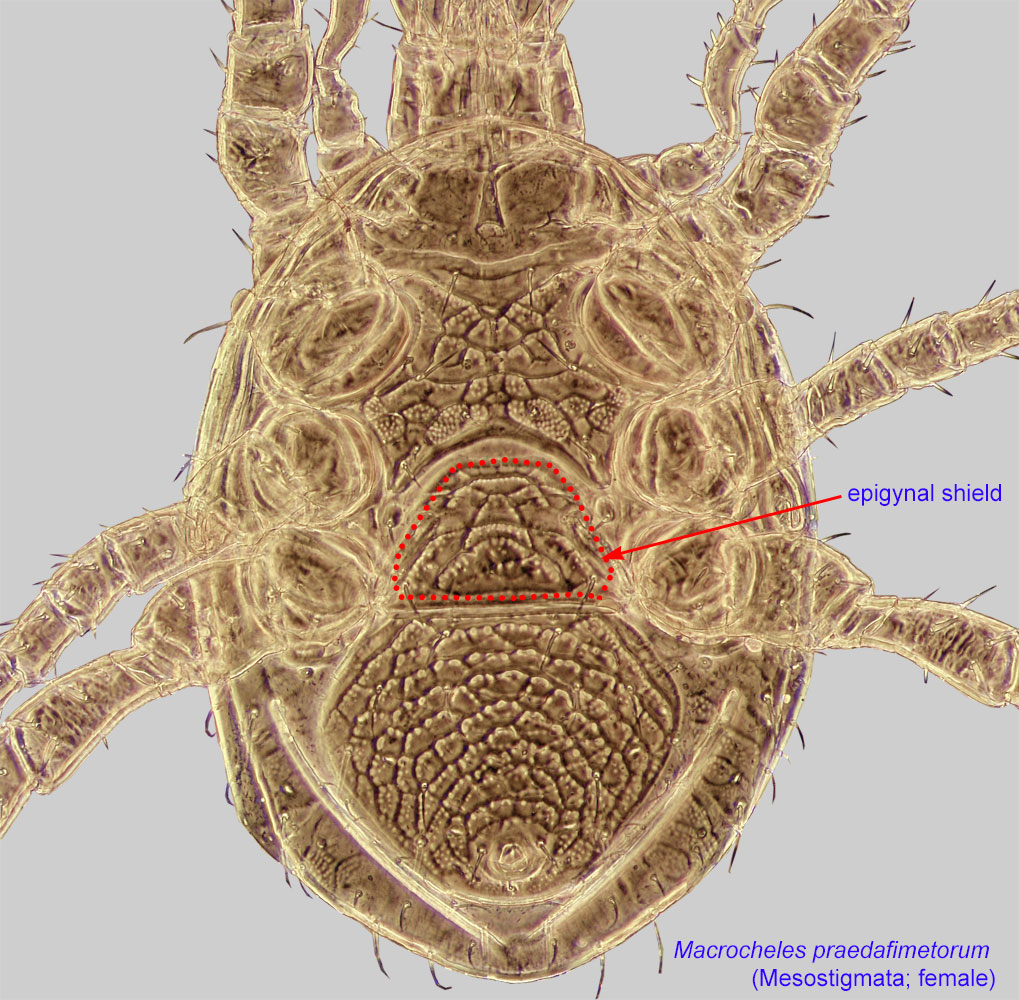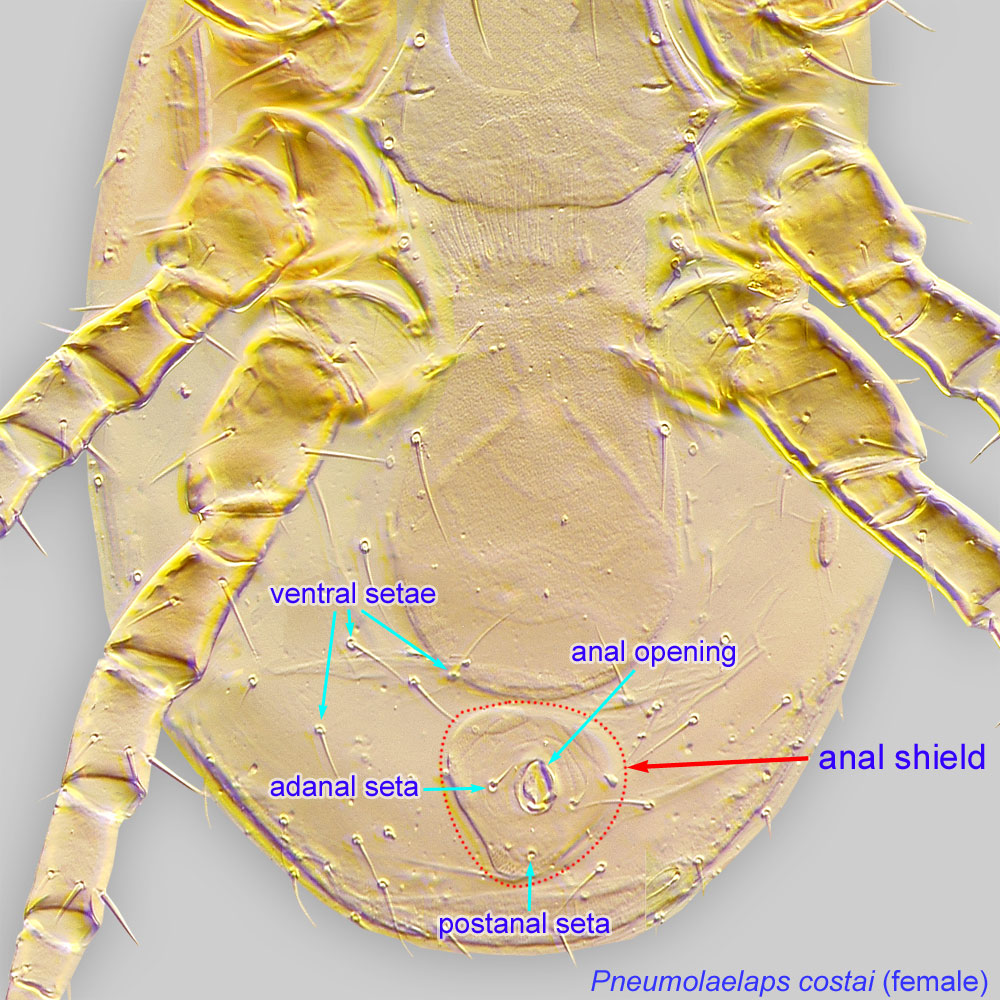biology not known
Bisternalis Hunter, 1963Hunter, 1963:
Hunter, P. E. 1963. Two genera of mites associated with stingless bees (Acarina: Laelaptidae). Acarologia. 5:5-12.
Superorder Parasitiformes » Order Mesostigmata » Suborder Monogynaspida » Hyporder Dermanyssiae » Family Laelapidae » Genus Bisternalis
Bisternalis rettenmeyeri Hunter, 1963Hunter, 1963:
Hunter, P. E. 1963. Two genera of mites associated with stingless bees (Acarina: Laelaptidae). Acarologia. 5:5-12.
Female: Epigynal shieldepigynal shield:
A shield protecting the female genital opening. Well-developed in Mesostigmata. Also known as epigynial shield.
 narrows posteriorly (can be pointed or bilobed at tip) (Figs. 2, 5). Anal shieldanal shield:
narrows posteriorly (can be pointed or bilobed at tip) (Figs. 2, 5). Anal shieldanal shield:
In Mesostigmata, a ventral shield bearing the anal opening and circumanal setae (adanal or postanal setae), but without any ventral setae or pores (lyrifissures) on it. If ventral setae are present on shield than referred to as a ventrianal shield.
 with anterior-lateral horn-like projections (Figs. 2, 5). Anterior part of sternal shieldsternal shield:
with anterior-lateral horn-like projections (Figs. 2, 5). Anterior part of sternal shieldsternal shield:
A shield in the anterior intercoxal region of parasitiform mites that bears one or more pairs of sternal setae.
 is completely (e.g., Bisternalis rettenmeyeri) or partially (e.g., Bisternalis mexicanus) separated from the remaining sternal shieldsternal shield:
is completely (e.g., Bisternalis rettenmeyeri) or partially (e.g., Bisternalis mexicanus) separated from the remaining sternal shieldsternal shield:
A shield in the anterior intercoxal region of parasitiform mites that bears one or more pairs of sternal setae.
 (Figs. 3, 4), hence the name of this genus. However, in one species, Bisternalis camargoi, the anterior part of sternal shieldsternal shield:
(Figs. 3, 4), hence the name of this genus. However, in one species, Bisternalis camargoi, the anterior part of sternal shieldsternal shield:
A shield in the anterior intercoxal region of parasitiform mites that bears one or more pairs of sternal setae.
 is not separated.
is not separated.
The most recent dichotomous key to species is available in Baker et al., 1984Baker et al., 1984:
Baker, E. W., C. H. W. Flechtmann amp; M. Delfinado-Baker. 1984. Acari domum meliponinarum brasiliensium habitantes. VI. New species of Bisternalis Hunter (Laelapidae: Acari). International Journal of Acarology.10: 181-189..
Similar to the genera Holostaspis (oophagous in ant nests) and Myrmozercon (intimate associates of ants) by their large epigynal shieldepigynal shield:
A shield protecting the female genital opening. Well-developed in Mesostigmata. Also known as epigynial shield.
 that narrows posteriorly (in many species) and anal shieldanal shield:
that narrows posteriorly (in many species) and anal shieldanal shield:
In Mesostigmata, a ventral shield bearing the anal opening and circumanal setae (adanal or postanal setae), but without any ventral setae or pores (lyrifissures) on it. If ventral setae are present on shield than referred to as a ventrianal shield.
 concave anteriorly (in many species).
concave anteriorly (in many species).
Bisternalis differs from Holostaspis and Myrmozercon by the anterior part of its sternal shieldsternal shield:
A shield in the anterior intercoxal region of parasitiform mites that bears one or more pairs of sternal setae.
 that is completely (e.g., Bisternalis rettenmeyeri) or partially (e.g., Bisternalis mexicanus) separated from the remaining sternal shieldsternal shield:
that is completely (e.g., Bisternalis rettenmeyeri) or partially (e.g., Bisternalis mexicanus) separated from the remaining sternal shieldsternal shield:
A shield in the anterior intercoxal region of parasitiform mites that bears one or more pairs of sternal setae.
 (Figs. 3, 4). However, in one species, Bisternalis camargoi, the sternal shieldsternal shield:
(Figs. 3, 4). However, in one species, Bisternalis camargoi, the sternal shieldsternal shield:
A shield in the anterior intercoxal region of parasitiform mites that bears one or more pairs of sternal setae.
 is typical (undivided), but its epigynal shieldepigynal shield:
is typical (undivided), but its epigynal shieldepigynal shield:
A shield protecting the female genital opening. Well-developed in Mesostigmata. Also known as epigynial shield.
 is pointed posteriorly (never pointed in Holostaspis).
is pointed posteriorly (never pointed in Holostaspis).
Bisternalis differs from Myrmozercon by the presence of well-developed claws (reduced or absent in Myrmozercon) and the presence of denticles (small, tooth-like processes) on cheliceral digits (not developed in Myrmozercon).
Neotropical region.
stingless bees (Lestrimelitta, Trigona, Melipona, and Partamona)
permanentpermanent:
associated exclusively with bees or their close relative, wasps; cannot live without these hosts